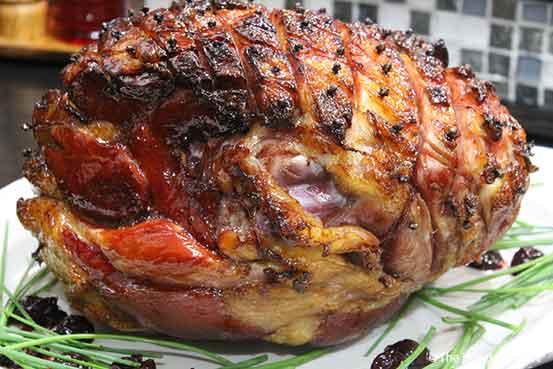
So, if I had to pick, ham is probably really close to the top of my list of favorite foods.
It’s salty. It’s succulent. It’s pink.
And, since you can glaze it with a zillion different types of sauce, it’s eminently customizable.
If you haven’t made a holiday ham before, never fear.
This guide will help get you through the big day, from shopping to baking and serving.
My first piece of advice about holiday ham?
Don’t believe all the hype. Seriously. Nobody needs to be running around the kitchen, stressed out of their gourds over a ham.
Holiday ham is easy breezy to pull off, once you sort out which kind of ham you’re gonna buy and how it’s best prepared.
This year’s ham at The Mouse House
For our ham this year, I studded it with cloves, then finished it off with a cherry-infused, brown sugar and spiced rum glaze that would make any pirate proud.
It was fantastic.
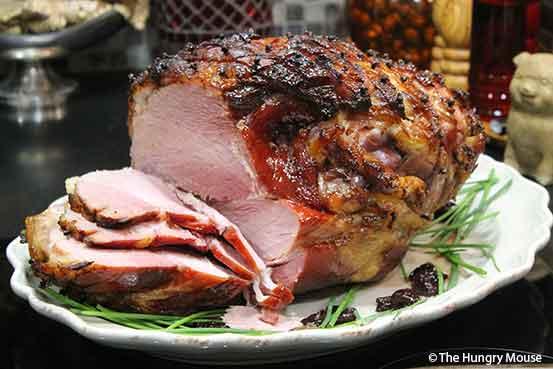
I snagged my honkin’ 19-pound, farm-raised smoked ham from my favorite local farm, Tendercrop Farm.
If you find yourself North of Boston, you should definitely check them out. I love these guys.
They raise a lot of the meat that they sell. Hands down, it’s my favorite place to buy meat. The butchers are great, really knowledgeable and the place is charming as can be.
Bonus? They have a petting zoo.

If it needs to be said, the peanut gallery was VERY interested in hanging around in the kitchen with me.
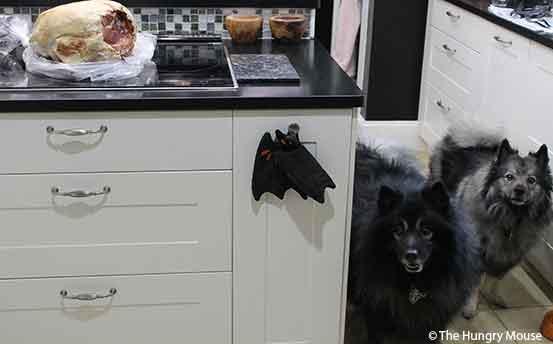
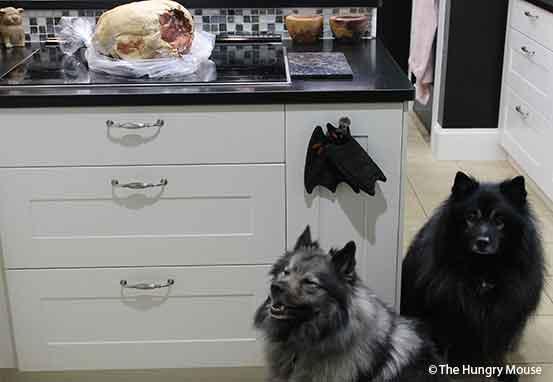
What kind of ham should you buy?
OK, so almost all hams that you will find in the store now are fully cooked, and just need to be heated through and glazed.
Unless you live near a farm and can get your paws on a fresh ham that hasn’t been smoked.
This is probably not a comprehensive list, but it’ll hit most of the big ones.
Some hams on the market today are pumped full of water and/or other fillers to plump them up.
So, if you’re concerned with going au natural, be sure to doublecheck the label or ask your butcher.
So what is ham, anyway? Ham is the cured rear leg of a pig, starting at the ankle (a.k.a. the shank) and ending at the rump. And, these days, you can buy it a zillion different ways.
There are two basic types:
Two ways hams are cured
- City ham—This basically means that the ham has been cured by soaking in (or being injected with) a salt-water solution that may or may not contain other stuff.
City hams are usually smoked, so they’re fully cooked and ready to eat. All you have to do is heat your ham up in the oven, and glaze it if you like.
These are the traditional, cheery Easter hams we remember from when we were kids, covered in pineapple rings and dotted with maraschino cherries.
- Country ham—This means that the ham has been dry rubbed with salt and spices, and hung to cure for months, au natural.
They can be smoked or sold raw, so check the label or talk to your butcher to find out.
Because they hang to dry, they dehydrate a bit, which means the flavor in these hams is more concentrated and they tend to be saltier.
6 common types of ham for sale
Here are the main kinds you’re likely to find at your local market or butcher.
When it comes down to it, if you care what’s in your ham, make sure you read the label on it carefully, or talk to the peeps behind the meat counter.
- Ham—This is 100% straight up pig. No fillers. No added water.
It can be smoked (which means it’s fully cooked and just needs to be heated) or fresh (which means that the meat is raw and you need to cook it through).
- Ham with natural juices—This ham must contain 18.5% protein by federal regulations and has been injected with up to a 10% solution.
(Sounds creepy and kind of nebulous, right?)
- Ham with water added—This ham has 10% water added, and must contain at least 17% protein by federal regulations.
This means that the ham has been injected with water to help keep it moist, improve texture, and boost the profit margins of the supplier.
This kind of ham is generally cheaper by the pound, but remember that what you’re buying is not all ham: Some of that weight is water.
Check the label for the details. It will say something like “10% water added.”
- Ham and water products, X% of Weight is Added Ingredients—This ham contains more filler than ham with water added (above), and can be less than 17% protein by federal regulations.
- Spiral sliced ham—These hams are already cooked AND pre-sliced to help you avoid carving nightmares.
The upside? They’re easier to serve.
The downside? Because they’re pre-sliced, they can dry out in the oven, so don’t slack on basting the beast if you go this route.
- Canned ham—This is the kind of ham in a can you can usually find year-round at the market, either in the refrigerated section, or just hanging out on the shelf.
It’s smooshed together from a bunch of different pieces of ham, and can be salty and wicked spongy.
It’s already cooked, so it’s safe to eat right out of the package. Think Spam and you’re not far off.
This usually contains gelatin and a bunch of other additives.
Want an insanely comprehensive list of types of ham, including a bunch you probably never even knew existed? Check out the FDA’s page on ham here.
Which end of the ham do you want?
You’ve got two choices:
- Butt end—This is the part of the leg near the rump, or butt.
The meat is flavorful and tender, and tends to be a little leaner.
But, if you get a bone-in ham, it can be tricky to carve.
- Shank end—This is the part of the leg near the ankle, or shank. This tends to be fattier and easier to carve, but can be a little tougher because it’s on the more muscle-y end of the leg.
Bone-in vs. boneless ham?
When I have the option, I always go for a bone-in ham.
- Bone-in hams—These guys will have more flavor because they’re cooked on the bone.
They can be harder to carve, but the bone will make AMAZING post-holiday soup or stock.
- Boneless ham—These guys are likely to be a little less flavorful (because they’re missing that tasty bone), but they’re way easier to carve.
They *can* sometimes have a funny texture from being squashed back together into ham shape after deboning.
What size ham should you buy?
It’s always hard when you’re feeding a crowd with a bunch of other dishes.
Most people recommend about a half-pound of meat per person.
I would increase that a little (maybe to 3/4 of a pound per person) if you’re buying a bone-in ham, since the bone counts for part of the weight, which means it will have less meat.
I always tend to go large, because I love the leftovers for sandwiches, soups, salads, biscuits, etc.
Ham glaze options
So, a lot of peeps would argue that the best part about a baked ham is that crispy, glazed skin.
For our ham this year, I rocked a cherry-infused rum glaze, inspired by those old-school hams dotted with Maraschino cherries.
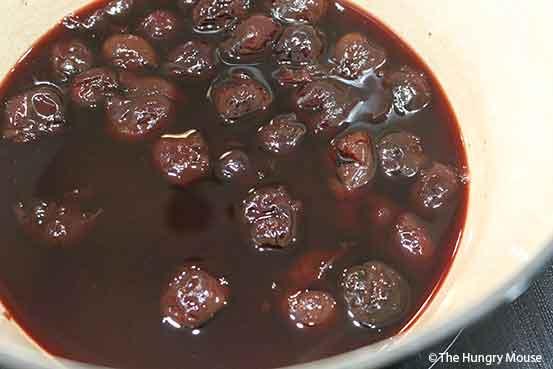
Here’s my glaze recipe. It was enough to baste my ham every 20 minutes for a couple of hours.
I basted the ham with the liquid, then saved the cooked cherries to use as part of the garnish on my serving platter.
Cherry-Infused Spiced Rum Glaze
12 oz dark cherries, stemmed and pitted (frozen works just fine if they’re all you have) 1 cup spiced rum (I used Sailor Jerry) Juice from 1/2 a large lemon 1 cup dark brown sugar
Directions Put all the ingredients in a small, heavy bottomed pot. Stir to combine.
Bring to a simmer over medium heat. Cover and simmer for about 30 minutes, or until the cherries are nice and soft.
Remove from the heat and set aside until you’re ready to glaze your ham.
How to bake a ham: The basic technique
Here’s the basic technique I used to bake my fully-cooked, smoked ham.
You want to bake it in the oven, covered, to heat it through, then glaze it, uncovered, until it’s richly lacquered.
- Score the skin in a diamond pattern
- Poke a clove into each diamond-shaped section of skin
- Roast covered for 2.5 hours at 325 degrees F
- Uncover, brush with glaze, return to oven for 20 minutes
- Brush with glaze again, return to oven for 20 minutes
- Repeat glazing and baking until the ham is a rich brown color and registers 140 degrees F on a meat thermometer. Use the chart below to ballpark timing.
- Rest for 20 minutes covered with foil (to help keep it juicy)
- Carve, serve, inhale
How long should you cook your ham?
This is the question, right?
How long you cook your beast depends, truly, on what kind of ham you bought.
Take a look at this chart from the FDA to figure out roughly how long to cook your ham.

My ham was smoked (so, fully cooked) and weighed just a hair over 19 lbs.
I baked it at 325 degrees F for 2.5 hours, then continued to bake it at 325 F, glazing it every 20 minutes for another 3.5 hours or so.
I started it around noon, and it was done around 6, in perfect time for dinner.
How to bake and glaze a fully cooked, bone-in ham
If you’ve done this before, you know what’s up.
If you haven’t, it can be pretty daunting facing a 10+ lb. hunk of pig for the first time. Here’s a quick visual guide to baking and glazing a fully cooked, bone-in ham.
Preheat your oven to 325 degrees F. Set a rack in a roasting pan that’s large enough to accommodate your beast. Grab your ham, and let the fun begin.
With a sharp, non-serrated knife, score the skin in a diamond pattern, cutting about 1/8 of an inch deep.
This will give you that classic, Easter-ham look. It will also help render some of the fat out of the skin.
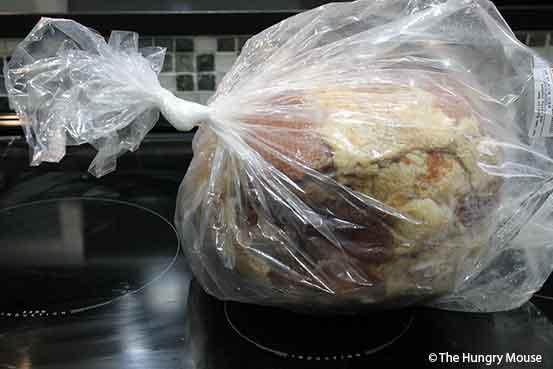
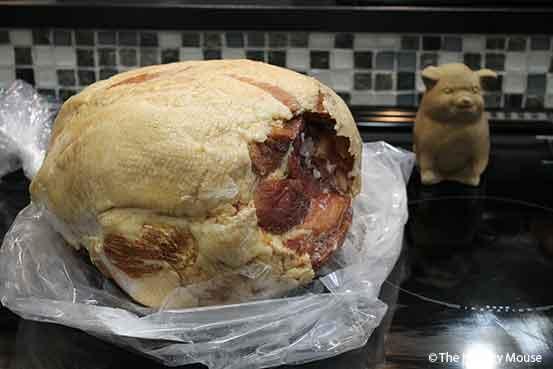
First, cut a row of lines (maybe about 3/4 of an inch apart) going one way across the ham.

Then, rotate the ham 180 degrees and cut another row of lines to create the diamond pattern.
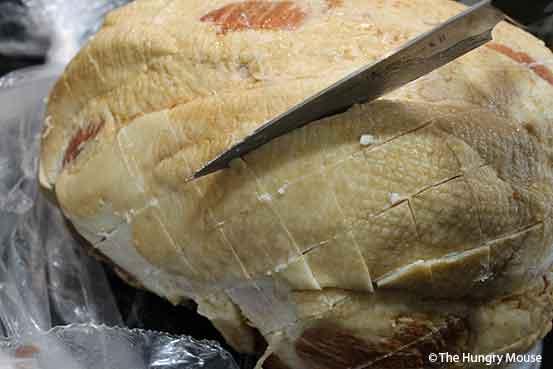
Stick a whole clove in the center of each diamond of skin. This is totally optional. Gives the ham a nice, spicy flavor.

Poke the cloves in, just like thumb tacks.
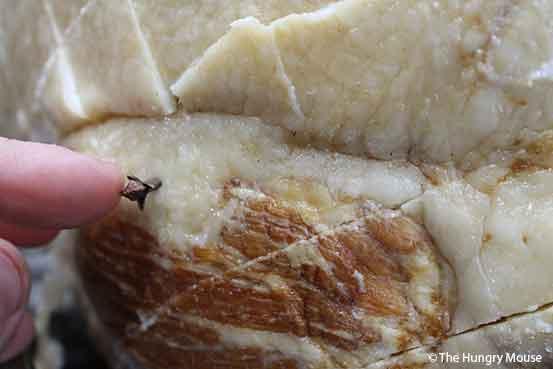

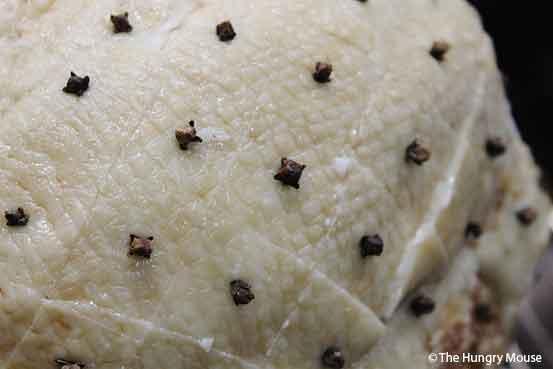
Next, cover the ham tightly with aluminum foil.
Pop him into your preheated, 325-degree F oven.
Bake by weight according to the chart above.
All told, my whole, 19-lb. ham took about 6 hours to bake and glaze.

After about 2 1/2 hours, I unwrapped my ham and brushed the first layer of glaze on him.
I popped him back into my 325-degree oven, UNWRAPPED, and baked him for about 20 minutes more, then brushed him with another layer of glaze.
I repeated this for about 3.5 hours, until he was a rich mahogany color.
Voila, the transformation:

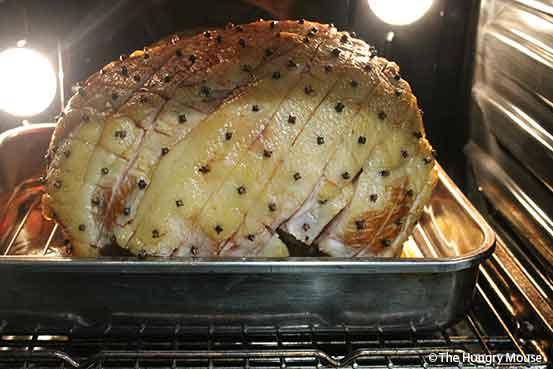
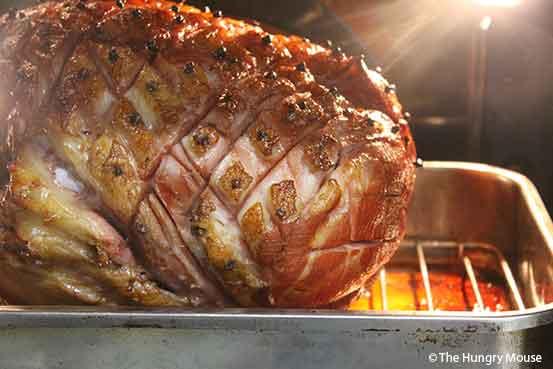
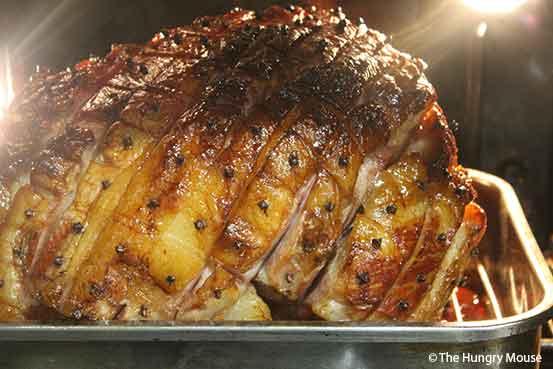
When your ham is done, yank him out of the oven. Tent loosely with foil for about 20 minutes to help his juices settle into the meat.
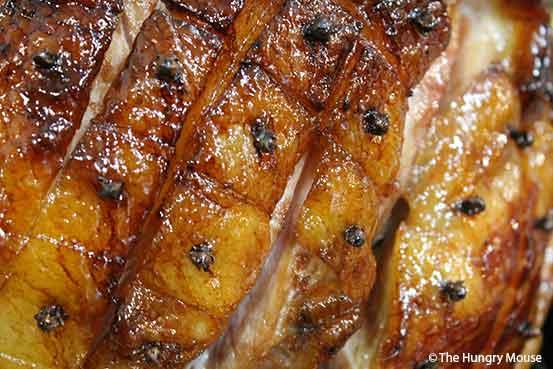
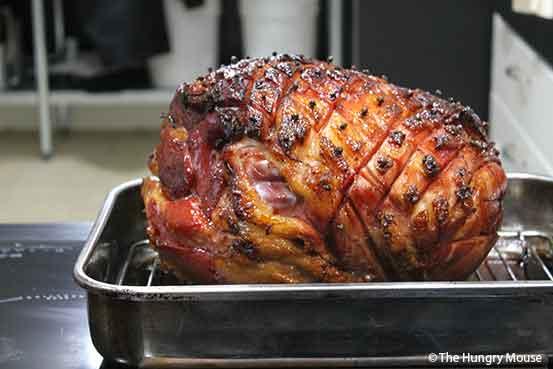
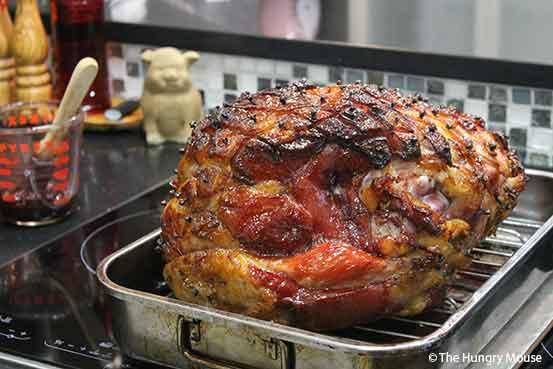
Transfer him to a serving platter. I garnished the platter with the leftover cherries from the glaze and a handful of fresh chives.
Simple, right?
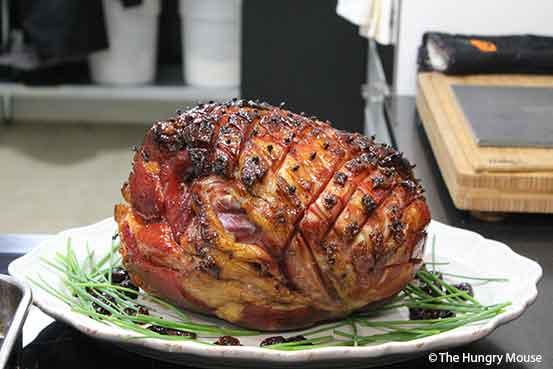
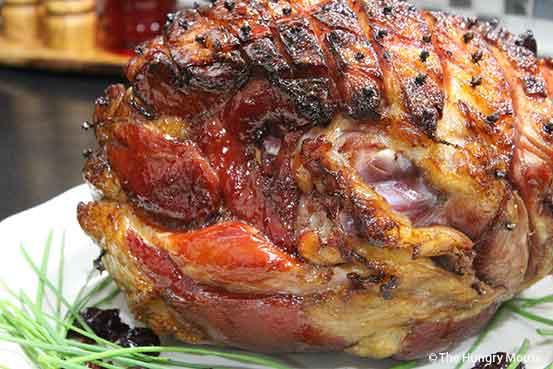
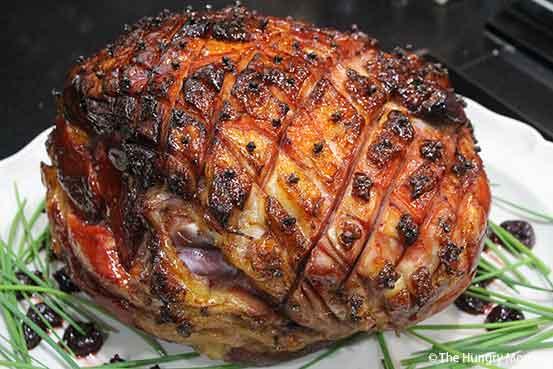
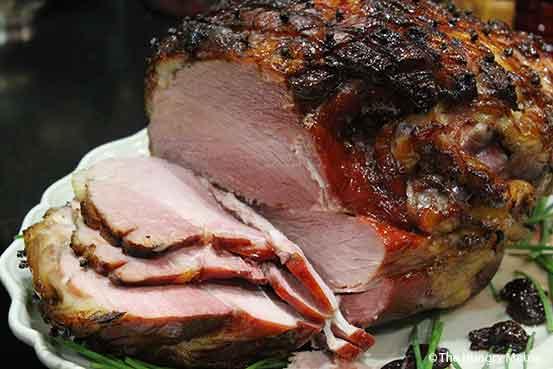
Carve, serve, and enjoy!
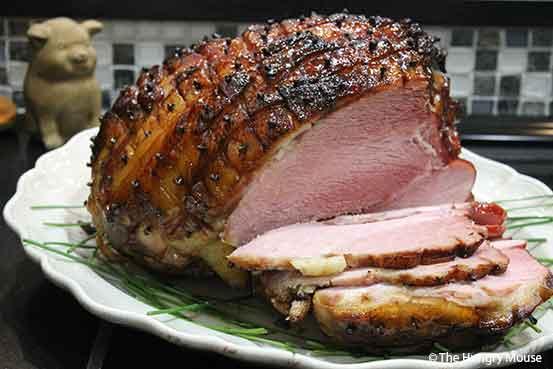
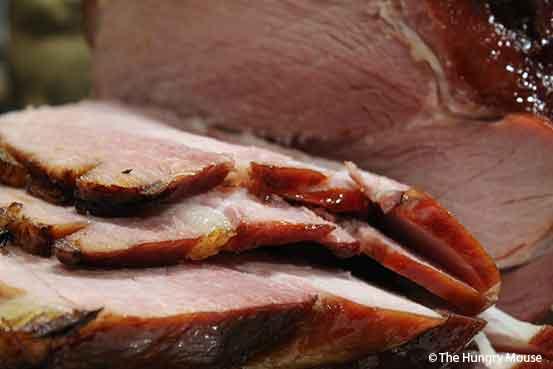
How do you make your ham?
Leave a comment below, let us know! Happy holidays!



